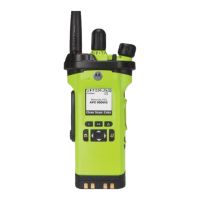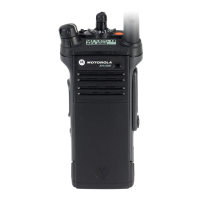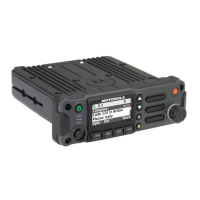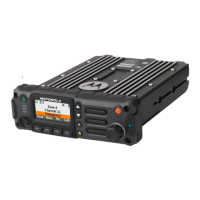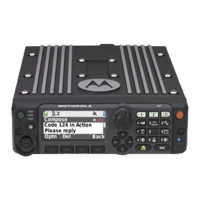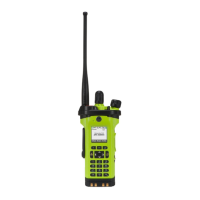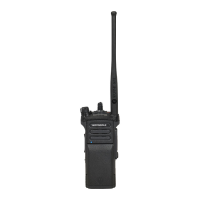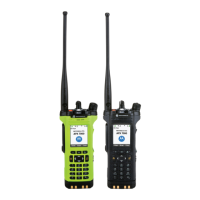3-10 Theory of Operation: Main Board
3.1.2.1 VHF Front-End
From the 15 dB Step Attenuator (U2702), a VHF signal is routed to the first pre-selector filter
followed by a Low Noise Amplifier (LNA) and a second pre-selector filter. Both filters are discrete
designs and are used to band limit the incoming energy and suppress known spurious responses
such as Image and the ½ IF spur. The LNA active device is an NPN transistor (U304) with active bias
provided by transistor pair (Q303).
The output of the second pre-selector filter is applied to the RF port of the Mixer IC (U507) via a
balun transformer (T506). The Mixer IC is driven by a Local Oscillator (LO) signal at the LO port to
down-convert the RF signal to a 109.65 MHz intermediate frequency (IF). The down converted IF
signal is passed through a crystal filter (FL502) which drives the input of the Abacus 3 Analog to
Digital Converter IC (AD9864) (U601).
3.1.2.2 UHF1/UHF2 Front-End
From the 15 dB Step Attenuator (U2602), a UHF signal is routed to the first pre-selector filter
followed by a Low Noise Amplifier (LNA) and a second pre-selector filter. Both filters are discrete and
tunable designs and are used to band limit the incoming energy and suppress known spurious
responses such as Image and the ½ IF spur. The LNA active device is an NPN transistor (U1932)
with active bias provided by transistor pair (Q1922).
The output of the second pre-selector filter is applied to the RF port of the Mixer IC (U507) via a
balun transformer (T506). The Mixer IC is driven by a Local Oscillator (LO) signal at the LO port to
down-convert the RF signal to a 109.65 MHz intermediate frequency (IF). The down converted IF
signal is passed through a crystal filter (FL502) which drives the input of the Abacus 3 Analog to
Digital Converter IC (AD9864) (U601).
3.1.2.3 700/800 MHz Front-End
From the 15 dB Step Attenuator (U2302), a 700 MHz or 800 MHz band signal is routed to an SPST
band select switch (U402) which selects the 700 or the 800 band signal and routes it to the
appropriate first pre-selector filter (FL401). A second band select switch (U404) selects the output of
the appropriate filter and applies it to an LNA followed by a similar pre-selector filter/ band-select
switch circuit. The signal is then routed to a second LNA (U407) whose output is applied to a discrete
image filter. Both preselector filters are Surface Acoustic Wave designs used to band limit the
received energy and suppress known spurious responses such as Image and the ½ IF spur.
The output of the discrete image filter is applied to the RF port of the Mixer IC (U507) via a balun
transformer (T506). The Mixer IC is driven by a Local Oscillator (LO) signal at the LO port to down-
convert the RF signal to a 109.65 MHz intermediate frequency (IF). The down converted IF signal is
passed through a crystal filter (FL502) which drives the input of the Abacus 3 Analog to Digital
Converter IC (AD9864)(U601).
3.1.2.4 900 MHz Front-End
From the 15 dB Step Attenuator (U2302), a 900 MHz band signal is routed to the first pre-selector
filter (FL401) which is used for signal band selection and applies it to a Low Noise Amplifier (LNA)
(U406). Signal out of the LNA is then routed to the similar pre-selector filter (FL402) before applies to
the second LNA (U407) for further amplification. Both pre-selector filters are Surface Acoustic Wave
designs used to band limit the received energy and suppress known spurious responses such as
Image and the ½ IF spur. The output of the LNA is applied to the RF port of the Mixer IC (U507) via a
balun transformer (T506). The Mixer IC is driven by a Local Oscillator (LO) signal at the LO port to
downconvert the RF signal to a 109.65 MHz intermediate frequency (IF). The down converted IF
signal is passed through a crystal filter (FL502) which drives the input to the Abacus 3 Analog to
Digital Converter IC (AD9864)(U601).
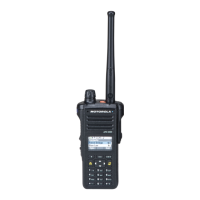
